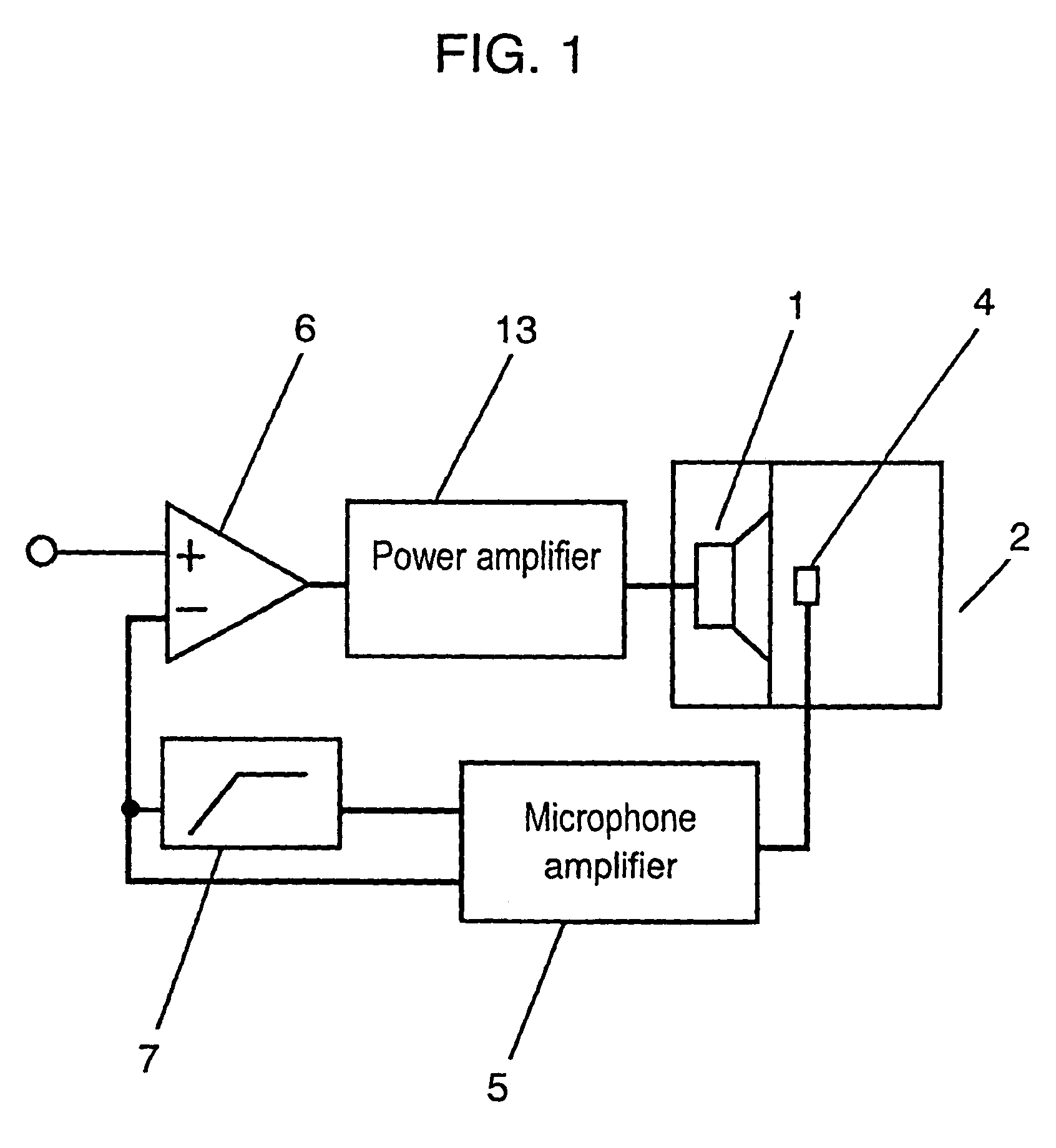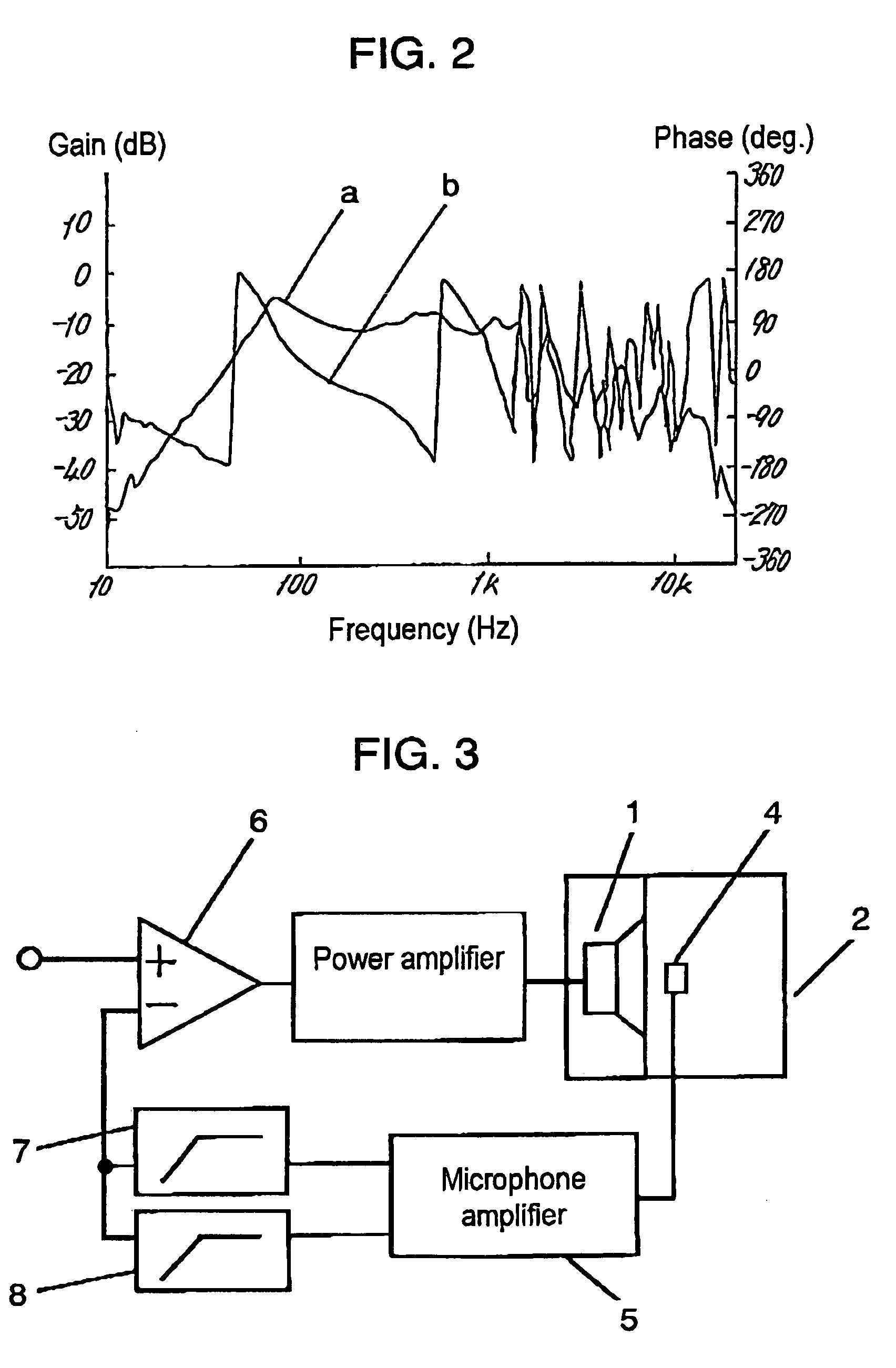Loudspeaker device
a loudspeaker and speaker technology, applied in the direction of transducer casings/cabinets/supports, frequency response correction, electrical transducers, etc., can solve the problems of ineffective sound absorption materials, difficult to flatten the sound output characteristic, and inability to control a certain desired frequency component, etc., to achieve the effect of suppressing peaks and dips in the frequency characteristics of sound pressure and stable characteristics
- Summary
- Abstract
- Description
- Claims
- Application Information
AI Technical Summary
Benefits of technology
Problems solved by technology
Method used
Image
Examples
first embodiment
[0027]FIG. 1 shows a block diagram of an acoustic circuit in accordance with a first exemplary embodiment of the present invention. FIG. 2 is a sound output characteristic chart; where, curve “a” shows the sound pressure characteristic, while curve “b” shows the phase characteristic. Initially, the overall structure of the speaker device is described referring to FIG. 1.
[0028]Referring to FIG. 1, in front of a speaker unit 1 an acoustic pipe 2 is coupled to the speaker unit 1, and a microphone 4 is mounted within the acoustic pipe 2. Sound waves radiated from the speaker unit 1 are detected by the microphone 4 within the acoustic pipe 2. The detected signals are delivered to a subtracter 6 via a high-pass filter 7, and at the same time, the signals detected by the microphone 4 are input directly to the subtracter 6 to be mixed with input signals coming from outside in order to correct the input signals. The corrected signals are amplified at a power amplifier 13 and delivered to the...
second embodiment
[0032]FIG. 3 shows a block diagram of a sound circuit in accordance with a second exemplary embodiment of the present invention. FIG. 4 (A) shows a microphone output signal characteristic, FIG. 4 (B) shows acoustic output characteristics, where, curve “a” shows a sound pressure characteristic, while curve “b” shows a phase characteristic. A difference compared to the first embodiment is that a negative feedback circuit in the present embodiment is formed by delivering the acoustic output signals detected by microphone 4 to the subtracter 6 via a couple of high-pass filters 7 and 8 connected in parallel. The filter 7 is the secondary high-pass filter (−12 dB / oct), while the filter 8 is the primary high-pass filter (6 dB / oct).
[0033]According to FIG. 8 (A), which shows the frequency characteristic of the microphone signal of the conventional device, the feedback is performed covering even the low frequency region components, which means the low frequency region components are enhanced....
third embodiment
[0036]FIG. 5 shows a block diagram of a sound circuit in accordance with a third exemplary embodiment of the present invention. FIG. 6 (A) shows the microphone output signal characteristics, FIG. 6 (B) shows the sound output characteristics, where, curve “a” shows the sound pressure characteristic, while curve “b” shows the phase characteristic. A difference compared to the first embodiment is that a negative feedback circuit in the present embodiment is formed of a couple of filters 7 and 9. A secondary high-pass filter 7 for processing the output signal detected by the microphone 4 and delivering to the subtracter 6, and a low-pass filter 9 of −12 dB / oct, or −6 dB / oct, for processing the output signal detected by the microphone 4 and delivering to the subtracter 6.
[0037]The low-pass filter 9 can take out only the low frequency region components for phase correction. Thus, the output sound characteristic can be corrected for the low frequency region components alone. The secondary ...
PUM
 Login to View More
Login to View More Abstract
Description
Claims
Application Information
 Login to View More
Login to View More - R&D
- Intellectual Property
- Life Sciences
- Materials
- Tech Scout
- Unparalleled Data Quality
- Higher Quality Content
- 60% Fewer Hallucinations
Browse by: Latest US Patents, China's latest patents, Technical Efficacy Thesaurus, Application Domain, Technology Topic, Popular Technical Reports.
© 2025 PatSnap. All rights reserved.Legal|Privacy policy|Modern Slavery Act Transparency Statement|Sitemap|About US| Contact US: help@patsnap.com



